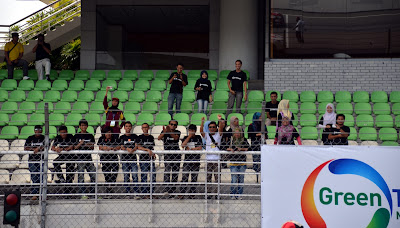PGMC2012 is an initiative of PROTON, together with Agensi Inovasi Malaysia, to promote electric vehicles. Teams compete to build the best performing EV based on a standard 2nd generation Proton Saga.
In the afternoon, two challenges were held together: Challenge 2: Fastest Time for 2 Laps and Challenge 3: V-Max
In between Challenge 1 and Challenge 2 & 3, the organisers provided some time for a pit walk session. Spectators are allowed to go into the pits to mix with team members and look closely at the electric cars.
The second day is the day of 'performance' challenges. It started with the scrutinising and safety inspection of the cars. Then, Challenge 1: Quarter Mile Acceleration starts.
While most of the team work on the car, some members focused on sprucing up the pit. This is because there are also prizes on team identity and pit display.
It's October 5th, and finally, we're in SIC. The first day started with the registration and scrutinising of all 10 cars by the PGMC 2012 TC. Only four team members were allowed to be present during the inspection.
When using batteries as the power source, a battery management system (BMS) is very important. We use the Orion Li-Ion BMS.
As an electric vehicle, the batteries used in the car has to be charged from time to time. The 12 V lead-acid car battery also has to be charged while the car is running.
In order to get an idea of where the hottest and coolest parts of the components might be, we made use of a thermal imager.
When PROTON initially gave us the car, it was a Saga BLM 1.3 model. However for this competition, PROTON then decides to standardise the cars, based on the Saga BLM 1.6 model.
The motor controller given to us was preprogrammed. To win a race however, one has to evaluate the objective of the race and tune the controller accordingly.
On 17 September, teams were again invited to the Sepang International Circuit, where the challenge will be held, for driver circuit familiarization.
Thermal management consists of the management of heat dissipation of the motor, motor controller and lithium-ion batteries with different methods.
The I.C.E. Terminator EV is moving!
With the new electric engine in place, we reconnect all the wires and install the vacuum pump. Put the tyres back on and it's system go.
We have had some problem with adapting the transmission to fit the motor and the car. But finally, we got the parts together and mounted the new electric engine.
For the purpose of safety and thermal management, the batteries must be enclosed in some sort of compartment.
The concept of ICEV to EV conversion is simple enough where the original engine is to be replaced with the electric motor provided by the organizer.
Following the previous visit, PROTON and the PGMC2012 Technical Committee visit the teams again for the third progress update. They visited us on 14 August.
Now that the car and its electrical engine system are together in the EV Lab, the wiring of the two can be integrated together.































































